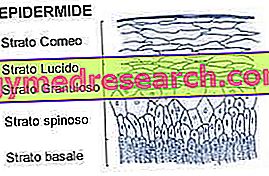Skin color and tan
The phototype of an individual plays a fundamental role in the tanning process. Depending on the skin type, in fact, it is possible to determine which reactions the skin can undergo in the event of sun exposure. It is not by chance that the individual's ability to tan is strongly dependent on the phototype of belonging.

"Photosensitivity is defined as" an abnormal response to light (in this case solar), which causes the appearance or deterioration of some dermatological pathologies ".
What is the phototype?
As mentioned, thanks to the phototype it is possible to determine how an individual's skin reacts to exposure to UV rays, just as it is possible to predict what type of tan it is possible to obtain.
Therefore, in light of what has been said so far, the phototype can be defined as a classification method used in the dermatological field in order to determine a person's skin type according to his sensitivity to sun exposure.
The phototype of an individual is determined by the quantity and quality of the melanin present in the skin which gives it its characteristic and unique color.
phototypes
In white skin populations, four classes can be identified in decreasing order of photosensitivity, corresponding to as many phototypes. However, dermatology divides phototypes into six distinct classes, including populations ahead of a very dark and black complexion.
These classes will be briefly described below.
Phototype I

Albinos fall into this group and for them, sun exposure should be limited to the maximum and in any case assisted by sunscreens with maximum protection.
Phototype II

However, the phototype II, although normally burns, gradually takes on a slight pigmentation; he should expose himself to the sun gradually avoiding at first the hottest hours and using screens with very high or total protection (SPF 50 or 50+, in case the skin is already tanned even 30).
Phototype III

The skin type III burns moderately, gradually tans to a light brown color. Even in the winter months the skin remains brown; the photosensitivity is low but it can burn itself and for this it must however use medium protection sunscreens (SPF 30 or 20, if the skin is already tanned even 15).
Phototype IV

The skin type IV is not hot enough, it tans quickly to a dark brown color.
It is the most fortunate of the four phototypes normally found in white skin populations, precisely because it has a particularly dark pigmented skin that is difficult to burn, it can guarantee adequate protection even using products with medium-low shielding power (SPF 20.15 or 10 if the skin is already tanned).
Phototype V

Phototype VI

Please note
The classification of skin types based on the color of the eyes and hair and based on the type of complexion is not always valid. In fact, not necessarily an individual with skin type I will have light hair and eyes, but could, instead, be brown with brown eyes; just as it is not necessarily true that a person with phototype IV has dark colored eyes and hair, since he could, for example, have light eyes and dark blond hair.
For this reason, in these cases, the discriminating factor for the determination of the phototype will be without any doubt the color of the skin.
Phototype and Children
As for children, it is necessary to make a separate speech. In fact, compared to an adult - even with the same skin phototype - children have an extremely more sensitive skin to the sun and more susceptible to sunburn and to the development of sunburn or pathologies related to uncontrolled sun exposure. Precisely for this reason, they should ALWAYS be protected by solar filters with a high protection index.



